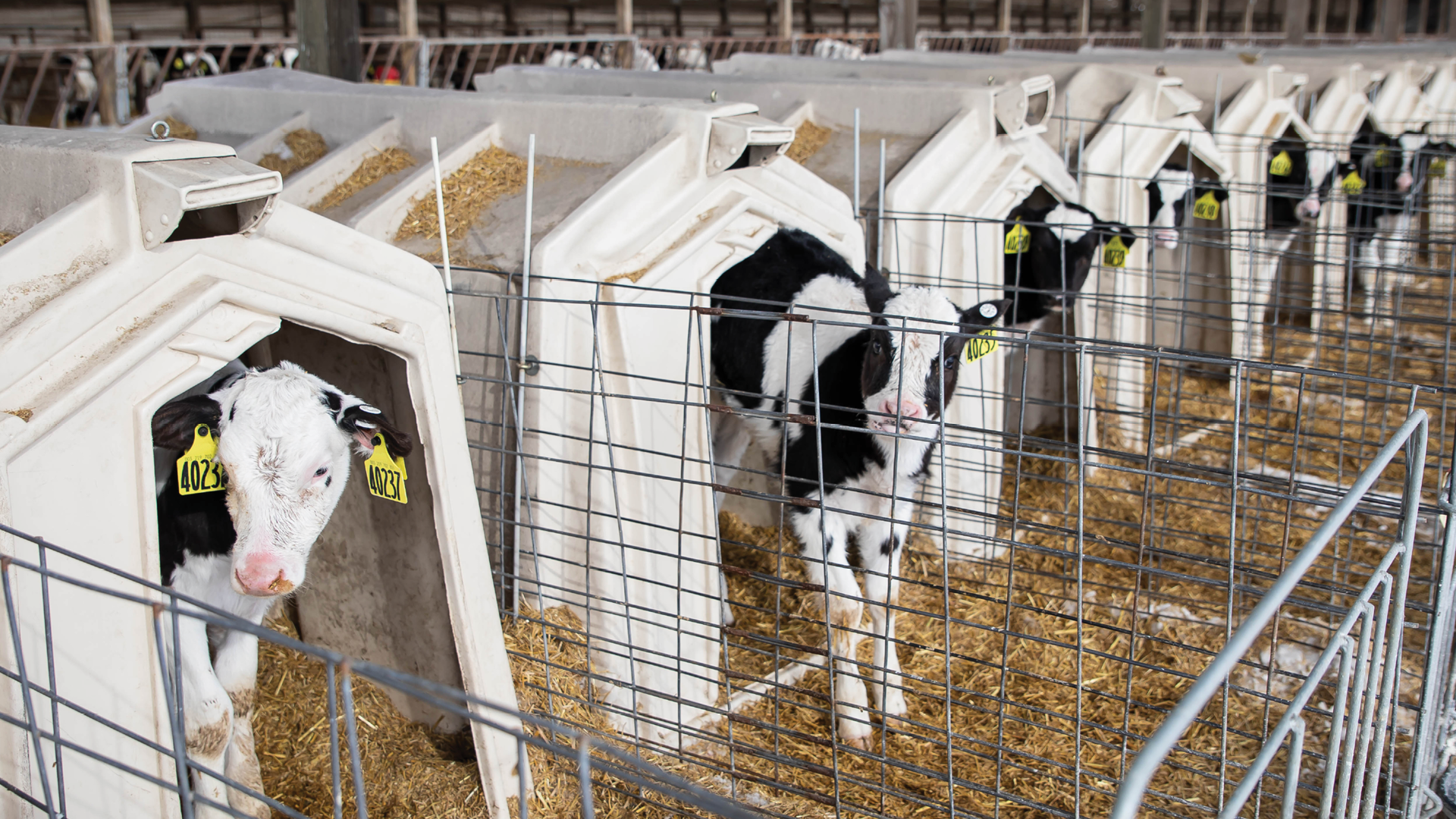Checklist for newborn calves moving to hutches
By Dr. Brian Miller
Unlike most mammals, the bovine species has a unique placentation that does not allow in-utero transfer of protective antibodies. Therefore, newborn calves are extremely vulnerable to diseases once they leave the protective environment of their mother’s womb.
Although the immune system of a calf is functional at birth, it is less responsive and less protective than the immune system of an adult cow.1 Because their immune systems are still developing, it’s critical to limit calves’ exposure to bacteria, viruses, and parasites to reduce the risk of illnesses.

The care that calves receive in their first few weeks of life can have a dramatic impact on future performance, productivity, and profitability. Use the following checklist to improve immune function, minimize disease risks, improve growth rates, and optimize pre-weaned calf health.
Understanding the disease triangle below can help formulate prevention strategies to reduce respiratory disease. The disease triangle and the “balance” between each of the three components and their contribution to disease provides the framework for respiratory disease prevention. Recognize that this “balance” is not static and is always a moving target.
Environment
- Prioritize the comfort and cleanliness of the maternity pen the calf is born into.
- The maternity pen should be an area for birthing only. Restrict entry of disease carrier dams or people that have just worked with sick cattle or calves.
- Calves that are born into bedding highly contaminated with fecal material will have immediate exposure to numerous pathogens from direct contact or aerosolization.
- Reduce pathogen exposure by removing the calf before standing attempts, and use sanitized transport equipment to move the calf to a clean holding area for processing.
Strategic vaccination
- Immunize late-gestation dry cows and replacement heifers with a scours vaccine to fortify colostrum with antigen-specific antibodies to help reduce diarrhea risks in neonatal calves.
- Review considerations for choosing a scours vaccine as part of a calf scour prevention program.
- Administer an intranasal respiratory vaccine to newborn calves that includes protection against respiratory viruses (IBR, BRSV, PI3) and bacteria (Pasteurella multocida, Mannheimia haemolytica).
- Intranasal vaccines are not affected by maternal antibodies from colostrum, are easier on the calf and are less likely to induce systemic inflammation compared to injectable vaccines (C. Chase DVM, personal communication, May 2022).
Colostrum management
- Harvest colostrum from suitable donors utilizing clean equipment and utensils, and ensure that each calf receives enough high-quality colostrum.
- Utilize a Brix refractometer to ensure colostrum is of high quality. High quality = IgG levels >/= 50 g IgG/L.
- Feed all calves fresh or pooled pasteurized colostrum within one to two hours of birth.
- The recommended volume is 10% to 12% of the birth weight (BW) at first feeding, followed by a second feeding (5% BW) 12 hours later. (S. Godden DVM, personal communication, May 2022).
- The goal of successful passive transfer is to deliver >/= 300 g of IgG.4
Navel dip
- Dip (don’t spray) the navel following birth with a 7% tincture of iodine to help reduce the risks of navel and joint infections and bacterial pneumonia.
- Wash off any navel contaminants, like fecal material or mud, with water prior to dipping.
- Use a disposable cup to dip the navel of each calf. Discard the cup after usage.
Tagging
- Apply ear tags to identify the calf for health monitoring purposes, to record age and to link the calf to the farm of origin.
- Review and train employees on proper ear tagging techniques.
Weight
- Record calf weight as a benchmark to monitor growth and performance.
Hutch management
- Make sure calf hutches have adequate drainage and are cleaned and sanitized prior to new calf entry.
- Long-stemmed straw is the bedding of choice in cold weather climates.
- Calf coats are necessary in cold weather climates to help maintain core body temperature and reduce the risk of hypothermia.
Feed and water
- Each calf should have its own grain and water bucket.
- Consistent feeding practices (timing, temperature, percent solids) are keys to health, helping to prevent gastrointestinal problems.
- Provide fresh water within 20 to 30 minutes after a milk meal, adjusting volume for age and climate.
- Water is necessary to maintain adequate hydration, optimize immunity and improve average daily gain.
- Clear nasal and ocular discharge are good indicators of proper hydration.
Monitor
- Observe calves visually each day for signs of disease and provide treatment and rehydration as needed.
- Scours and pneumonia are the most frequent diseases that affect pre-weaned calves.
Blood draw
- At one to 10 days of age, pull blood to measure serum total protein (STP) levels to evaluate a colostrum management program. Ongoing monitoring helps to more quickly identify and correct problems.
- This is also a good time, as part of an overall Bovine Viral Diarrhea Virus (BVDV) biosecurity strategy, to screen for BVDV to determine if calves are persistently infected.
Adequate colostrum, sufficient nutrition and a clean, quality environment are the foundations of calf health. Establishing and reinforcing a calf care checklist helps ensure stronger and more vigorous calves.
Consult with your herd health veterinarian regarding calf care protocols and vaccination decisions, then rely on trusted staff personnel to carry out the recommended procedures.
References
- Dr. Sheila McGuirk, Managing the young calf – Keep it simple!
- Lombard et. al., J Dairy Sci, 2020;103(8).
Find more content for your dairy operation.
About the author

Dr. Brian Miller, D.V.M.
Dairy Technical Services,
Merck Animal Health
